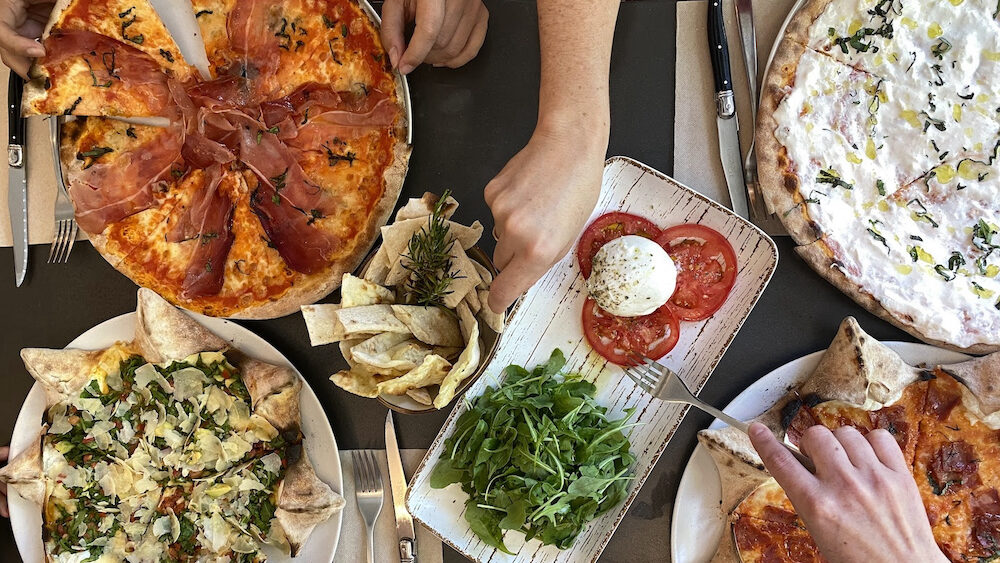It’s about to happen: The National Restaurant Association forecasts that restaurant sales will top $1.1 trillion in sales this year, marking a new milestone for the industry. But nagging questions remain: Will restaurateurs’ profits go up, too? And will they have enough employees to keep the business running?
The trade association has released its 2024 State of the Restaurant Industry Report, and there’s plenty of good news for the coming year. Consumers are feeling pretty OK about the economy overall. On the other hand, about 70% say they’re still angling for daily specials and discounts when dining or ordering out. And 75% say they’d be fine with smaller portions for a lower price.
Key findings from this year’s report include:
- Positive sales expected: Restaurant operators are cautiously optimistic about the year ahead, with nearly 8 in 10 predicting their sales will increase (33%) or hold steady (45%) from 2023 levels.
- Delivery, carry-out and drive-thru growth continues: 52% of consumers—including 67% of millennials and 63% of Gen Z adults—say ordering takeout from a restaurant is an essential part of their lifestyle.
- Help still wanted: Forty-five percent of restaurant operators report needing more employees to meet customer demand and a majority (70%) have job openings that are hard to fill.
- Profitability remains challenged: Operators are slightly less optimistic about profitability, with only 27% of operators expecting to be more profitable this year. Average food costs have increased more than 20% and average wages more than 30% from 2019—both impacting profitability.
- Jobs drive consumer spending: All restaurant sales are local, and consumers are generally upbeat about their community. Fifty-five percent of adults describe their local economy, including the availability of jobs, as excellent or good.
Related: Lessons in survival: What this start-up pizzeria operator has learned so far
“With more than $1 trillion in sales expected this year, the state of the restaurant industry is strong thanks to the agility of its operators and employees,” said Michelle Korsmo, president and CEO of the National Restaurant Association. “As our report shows, restaurants are finding ways to adapt to the challenges of increased food costs and supply chain disruption. Restaurants have responded well to customers’ desire to have more opportunities to enjoy restaurant meals, which continues to grow sales, create employment opportunities and foster a strong sense of community.”
Technology, Special Deals and Promotions
According to the report, consumers’ affinity for technology in restaurants varies and, as a result, operators are strategically deciding how to incorporate technology into the experience. For full-service restaurants, nearly half (46%) of adults think technology has a positive impact, and this number weighs heavily towards younger consumers (64% of Gen Z and 66% of millennials). Similarly, this younger group is more likely to want more technology options, according to the research.
These preferences can help operators make informed decisions on where and how to invest. In 2023, just under half (48%) of operators made technology investments to enhance the customer experience, but 60% plan to make an investment in 2024. The areas where consumers say technology would have the most positive impact on their personal experience include options that make ordering and paying easier and faster.
Related: This pizza chain keeps winning the ordering app war
If consumers are somewhat split on technology, they can agree on the value of a special deal or discount, with 7 in 10 adults saying they often look for a daily special or discount. Customers (85%) are more flexible about when they dine if it comes with a deal, and 84% said they’d take advantage of deals offered for dining at off-peak times.
Further, 75% of adults would opt for smaller-sized portions for a lower price—a trend that can help restaurants curb food waste and improve profits. To further fuel customer retention, the data suggests focusing on loyalty and rewards programs. Customers prefer to see this type of program on a smartphone app, further enforcing the need for technological innovation and creating additional touchpoints between customers and restaurants.
Restaurant Employment in 2024
The industry is projected to add 200,000 jobs in 2024, bringing total industry employment to 15.7 million. Between 2024 and 2032, the industry is projected to add 150,000 jobs per year on average, with total staffing levels reaching 16.9 million by 2032.
Despite this expansion, 45% of operators say their restaurant doesn’t have enough employees to support existing customer demand. Operators looking for the necessary support are turning to the gig economy and technology. One in four operators say using gig workers to fill in staffing will become more common in their segment in 2024 and nearly half (47%) of operators say the use of technology and automation to help with the current labor shortage will become more common.
How Food Cost and Availability Influence Menus
If consumers notice menu changes on a more frequent basis, it’s often the result of increased food costs. In the past year, operators report needing to find new suppliers, removing items from their menus, adjusting portion sizes or substituting lower-cost items, all in response to elevated food prices. The availability of food items impacted menu composition as well, with more than three quarters (77%) of operators saying their restaurant experienced supply delays or shortages of key food or beverage items in 2023. These changes will present a challenge for operators, especially with most adults (86%) saying they like plenty of choices on menus.
Further directing menu choices are social media trends. Savvy operators are turning to TikTok and other social media platforms to be inspired and to fire up viral trends. Operators will need to be strategic in how they balance thoughtfully streamlined, food-cost-effective menus and enough variety to satisfy demand and lead the latest trends.
Off-premises remains a key area of opportunity, with a vast majority (88%) of customers reporting being satisfied with the variety of local food options for takeout and delivery. Customers are viewing take-out in new ways, with two thirds (67%) of adults saying they’d be interested in subscriptions that offer a specified number of meals each month for a designated price and half (53%) saying they’re open to supplementing home-cooked meals with restaurant-prepared items.
“This is an historic and exciting year for the restaurant industry,” said Hudson Riehle, senior vice president of the Research and Knowledge Group for the National Restaurant Association. “While challenges remain—including inflation, recruitment, higher operating costs and profitability—restaurant operators will continue to innovate and evolve to meet customer demands.”













